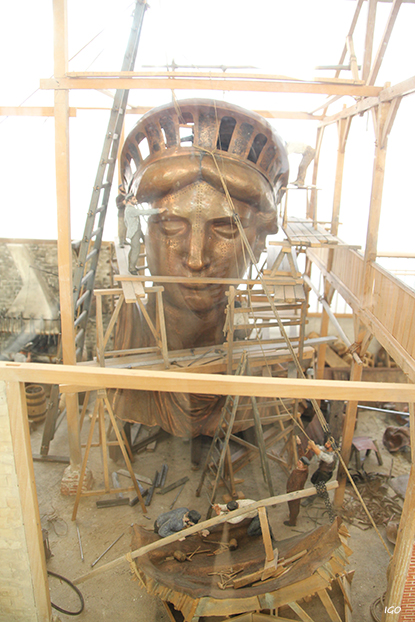 - Welcome - Sculpture
- Welcome - Sculpture
Sculpture
The subject is molded for the first time in clay by the sculptor. The substance is wetted several times to be able to rework the shapes as many times as necessary.
Afterward, a mold is manufactured based on this model. Next, plaster is cast into the mold to obtain the final version. This resulting model is used for all reproductions, regardless of the material used, such as bronze, marble, or plaster.
Defense of Paris by Louis-Ernest Barrias

Defense of Paris' sculpture - 1880
Defense of Paris is the name of a sculpture made by Louis-Ernest Barrias (1841–1905). It is also the name given to a competition in which around a hundred sculptors, like Bartholdi and Rodin, took part. The goal was to pay tribute to Parisians for the war of 1870-1871.
The work was inaugurated in 1883. This copy exhibited at the Petit Palais in Paris was made in patinated plaster to give it a bronze appearance. There is another bronze version of more than 3 tons in the business district of Paris, given the name of the La Défense district.
The Statue of Liberty by Auguste Bartholdi
The iconic sculpture of New York Harbor is an achievement of Auguste Bartholdi.
He grew up in the east of France. His birthplace in Colmar has been converted into a museum. He had studied in Paris and took classes at Antoine Etex's sculptural workshop.
A few months after completing his studies, he launches his small enterprise by becoming the owner of a workshop. When he traveled to Egypt, he became attracted to large-scale statues.
Edouard Lefebvre de Laboulay, president of the Franco-American Union Committee, initiated a subscription to recover the funds necessary for the creation of the Statue of Liberty, dedicated to the independence of the United States. The statue was inaugurated in October 1886.



Liberty enlightening the world.
Lafayette and Washington by Bartholdi
Lafayette defended an ideal of freedom and equality by wishing to fight the British colonists in America. His first crossing of the Atlantic was on board his ship, La Victoire, in 1777. He took advantage of this long crossing to learn to speak English. He crossed the Atlantic aboard the Hermione for this second trip. A replica of this frigate had been rebuilt in La Rochelle, thanks to the will of enthusiasts, the support of Erik Orsenna, and the city of Rochefort. A documentary search was carried out upstream, as well as a search for specialized craftsmen.
The American war ended with the signing of the Treaty of Versailles in 1783. Later, he fought for the emancipation of slaves. Appointed commander of the National Guard in Paris, he was forced to flee during the French Revolution. He returned to France in 1800.
His determination impressed George Washington. He received the title of Host of the Nation in New York during his last trip across the Atlantic. The statues of LaFayette and Washington are in Place des Etats-Unis in Paris. Manhattan Avenue in New York has a duplicate.

Sculpture of LaFayette and Washington by Bartholdi.
Jules Verne by Albert Roze
Albert Roze learned sculpture in a Parisian workshop for more than ten years. Back in his hometown, he took over as head of the Fine Arts Museum of Picardy. During World War I, he was careful to relocate priceless artworks to a secure location. He was the principal of the School of Fine Arts from 1893 to 1911 and taught students.
The subscription-funded sculpture of Jules Verne was unveiled at Amiens on May 9, 1909. Albert Roze made several statues for the war memorials, 14–18.
Albert Roze created several monuments to personalities, such as the one dedicated to the memory of Auguste Parmentier (1737–1813). This military pharmacist from Montidier has contributed to the potatoes' growth.

Jules Verne Sculpture
Lully as a child by Adrien Gaudez
Adrien Gaudez, originally from Lyon, studied at the School of Fine Arts in Paris. He studied under François Jouffroy. His low reliefs for the Civil War memorial in Indianapolis had won him multiple awards in Paris and the US. He made a sculpture in memory of the French prisoners of 1870 at Magdeburg, Germany.
Lully was born in Florence in 1632 and was 13 years old when he arrived in Paris. He was considered a child prodigy and was the king’s favorite musician. Louis XIV had named him superintendent of music in 1661. He was first hired as a kitchen boy at the French court. He is represented in this sculpture, preparing to play the violin with the cook's attributes: a hat, an apron, and a foot set on a saucepan.

Lully as a child.
